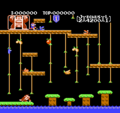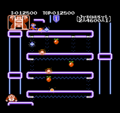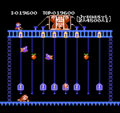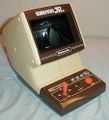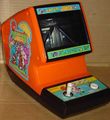Atari 2600[edit]
Developed by Coleco in 1983. Re-released by Atari in 1988. Does not contain the Springboard stage.
-
Stage 1
-
Stage 2
-
Stage 3
-
Coleco box
-
Atari box
Atari 7800[edit]
Developed by Atari in 1988
-
Stage 1
-
Stage 2
-
Stage 3
-
Stage 4
-
box
Atari 400/800/XL/XE[edit]
Developed by Atari in 1983
-
Stage 1
-
Stage 2
-
Stage 3
-
Stage 4
-
box
BBC Micro[edit]
Developed by Atarisoft, but not released.
ColecoVision[edit]
Developed by Coleco in 1983. Does not contain Mario's Hideout stage.
-
Stage 1
-
Stage 2
-
Stage 3
-
box
Game Boy Advance[edit]
Released as part of the e-Reader card series in 2002. It is a direct port of the NES version.
-
GBA e-Reader
Intellivision[edit]
Developed by Coleco in 1983. Does not contain Mario's Hideout stage.
-
Stage 1
-
Stage 2
-
Stage 3
-
box
NES[edit]
Developed by Nintendo in 1983.
-
Stage 1
-
Stage 2
-
Stage 3
-
Stage 4
-
Original box
-
Donkey Kong Classics box
ZX Spectrum[edit]
Developed by Atarisoft, but not released.
Vintage Handhelds[edit]
Before Nintendo designed the Famicom and the NES, they manufactured a series of handheld LCD games known as Game & Watch, some of which were based on their popular arcade licenses. All of the vintage handhelds of Donkey Kong Jr. were designed by Nintendo as part of their Game & Watch series.
Game & Watch widescreen[edit]
The most common Donkey Kong Jr. Game & Watch handheld, possibly due to the lower price point, was the widescreen version. It contains a single screen which is composed of a few elements taken from the Vines stage such as Snappers and Fruit, and the Springboard stage such as Nitpickers and moving vines. Junior starts out in the lower left corner, and must walk across the ground to reach the vines at the right side to climb up to the tree branch and cross back to the left. He must then jump up and grab the key which can unlock one of four sections of father's cage. Along the way, Snappers will cross the ground and tree limb while Nitpickers will fly over the ground making jumping or clinging to vines dangerous. If Junior unlocks the cage four times, papa will be freed and you will earn bonus points, before the game starts over at a faster pace. At 300 points, all lives that were lost are restored, and if no lives were lost, the game goes into double score mode until the first life is lost. Recreations of this version can be found on Game & Watch Gallery 3 for the Game Boy Color, and Game & Watch Gallery 4 for the Game Boy Advance.
-
Widescreen
-
Japanese and North American boxes
-
Mini Classics remake
Game & Watch multi-screen[edit]

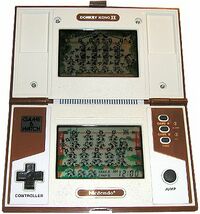
The handheld conversion which does not share exactly the same title as Donkey Kong Jr. is ironically the most accurate to the arcade version. It is less common, but more popular, than the widescreen Donkey Kong Jr. Game & Watch. It contains two screens which is an amalgamation of several stages including the Vines stage, Mario's Hideout, and the Chains stage. Junior starts out in the lower left corner of the bottom screen, and must walk across the ground to reach the vines at the right side, jumping over Snappers, but avoiding sparks overhead. He must climb up to the electric wire and cross back to the left, now jumping over sparks, but still avoiding sparks one electric wire higher. He must then jump up and climb another sets of vines that brings him up to the top screen. Once there, he must jump up and pop the key which will land in one of the four chain locks. You must climb up and push the key into the lock while Nitpickers weave back and forth among the chains. If Junior unlocks four chains, papa will be freed and you will earn bonus points, before the game starts over at a faster pace. At 300 points, all lives that were lost are restored, and if no lives were lost, the game goes into double score mode until the first life is lost. Recreations of this version can be found on Game & Watch Gallery 3 for the Game Boy Color.
Game & Watch tabletop[edit]
Nintendo noticed the popularity of Coleco's tabletop series of converted arcade games, and decided to publish a number of tabletop games for their Game & Watch series. Despite already having two G&W titles, Nintendo decided to give another one to Junior, probably due to his popularity among Game & Watch players. This third game was entirely new. While it featured the familiar aspect of needing to free Donkey Kong with four separate keys, it required that Junior travel back and forth across the screen each time to collect the key on the left, and free papa on the right. The left side of the screen consisted of a nearly maze like arrangement of tree limbs and vines that Nitpickers weave through. The right side contains balloons that rose and umbrellas that fell, in a manner similar to the Elevator stage in Donkey Kong, which Junior had to use to line up with father's locks before using the key. The tabletop did not have its own light source and relied, instead, on back lighting that was provided externally. Coleco had plans to design and release their own Donkey Kong Jr. tabletop, in a style that matched their previous releases, but they opted instead to repackage Nintendo's original design, coloring and decorating it so that it mimicked the look of the arcade.
-
Nintendo Tabletop
-
Nintendo box
-
Coleco Tabletop
-
Coleco box
Game & Watch panorama[edit]
The tabletop format did not sell in huge numbers like the rest of the Game & Watch series, possibly due to their cost which was higher than the other Game & Watches. Nintendo released three of the four tabletops in a cheaper format which they called Panorama. Like the tabletops, they required external back lighting in order to see the action on the screen, so they could not be played in the dark. The panorama version of Donkey Kong Jr. plays identically to the tabletop version.
-
Panorama
-
Box
-
Game Display


























